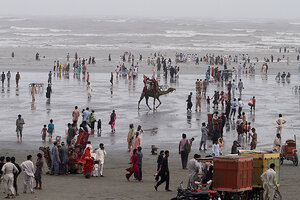China is building two untested nuclear reactors on Pakistan's coast
Pakistan has agreed to the construction of two nuclear reactors in Karachi, a coastal city in a tsunami-prone zone. After the 2011 Fukushima disaster in Japan, scientists and civil society activists are asking why.

People visit Clinfton beach, during a hot summer's day in Karachi, Pakistan, Sunday, July 5, 2015.
Fareed Khan/AP
Islamabad, Pakistan
Pakistan's largest city and financial hub has given China a green light to build two nuclear power stations on a beach about 15 miles from downtown, raising public alarm over both the location – the coastline is vulnerable to tsunamis – and the fact that the nuclear reactors are new and untested.
Karachi approved the plan in late June when the city’s environmental agency deemed, “after careful review,” that the project was safe. Yet the impact assessment on the reactor site, at a popular beach known as Paradise Point, remains secret.
Now environmentalists, nuclear experts and civil society activists are shouting with unusual gusto that the reactors, due to be completed by the China National Nuclear Cooperation, a state-owned company, within five years, represent a wholly unacceptable risk and fall far short of international safety standards.
“We have become the guinea pigs in this nuclear experiment,” says Pervez Hoodbhoy, a nuclear physicist and leader of the civic opposition. “Sensible people would not even buy a used car without driving it…and no airline would consider buying a new jet-liner without extensive testing. Nuclear reactors have systems far more intricate than those inside the most complex passenger aircraft.”
High population density
Earlier this year, Dr. Hoodbhoy and several petitioners obtained a stay of work on the project from the high court in Sindh Province, where Karachi is located. But Pakistan's federal government in Islamabad intervened to start the process again on ground of national security.
The court petitioners cited US Nuclear Regulatory Commission standards that civilian plants should be located in low population density zones with no more than 500 people per square mile.
The population density at the proposed Karachi site is some 6,450 per square mile; once the reactors are built there would be more people living and working in proximity to them than any other reactor in the world.
Yet the government of Prime Minister Nawaz Sharif, which pushed and sealed the deal for Karachi, appears more focused on tackling Pakistan's energy deficit. Karachi, a city of 20 million, faces its own acute shortages: More than 1,000 people died there last month in a heatwave, and the public has called for more electricity plants to power cooling systems.
China, for its part, represents the only producer ready to build civilian nuclear power stations in Pakistan, since Islamabad is not a signatory to the Nuclear Non-proliferation treaty and can’t make such purchases on the international market.
The model of reactor to be built in Karachi is the ACC-1000, also known as the Hualong-1. Based on Chinese designs adapted from a French prototype, it reportedly has additional safety features. But to date, the Chinese model only exists on paper as no reactors have been built. The Sindh court petitioners point out that in the 1990s, China sold Pakistan four reactors that, when first tested in China, had design problems that had to eventually be fixed by a US firm.
Safety vs. infrastructure investment?
Chinese President Xi Jinping in his first visit to Islamabad this spring promised $54 billion in infrastructure investment for Pakistan. And Pakistanis have been looking to China and its corporate sector as a potential savior, including for power generation.
In the 1990s, China was believed to have helped Pakistan develop its nuclear program after India tested a nuclear device.
“China is looking for nuclear customers and currently doesn’t have any except Pakistan,” argues Hoodbhoy, “and since Pakistan is forbidden from purchasing reactors from the open market, this leaves China as its sole supplier. So concerns of nuclear safety are being put on the backburner.”
The US embassy in Islamabad this spring issued a statement raising “concerns” with the Karachi nuclear project saying “we [the US] urge China to be transparent regarding this cooperation.”
Critics say the Chinese reactors pose a risk for some two-dozen coastal villages, along with Karachi, in the event of a Fukushima-type nuclear accident caused by tsunami or a quake.
Last fall after an UN-sponsored exercise on emergency preparedness, scientists said that a major quake in the Makran Trench in the Indian Ocean could trigger waves of between three and 23 feet along the Pakistani coast, including Karachi. A massive undersea quake in 1945 killed an unknown number of people there. The scientists said that the waves would likely hit the Karachi coast within 90 minutes.
“Going by the past record of both provincial and national disaster management authorities, you'd be hard pressed to find an iota of hope in their capability to manage any disaster let alone a nuclear disaster," says Norbert Almeida, an international corporate risk analyst based in Karachi.

